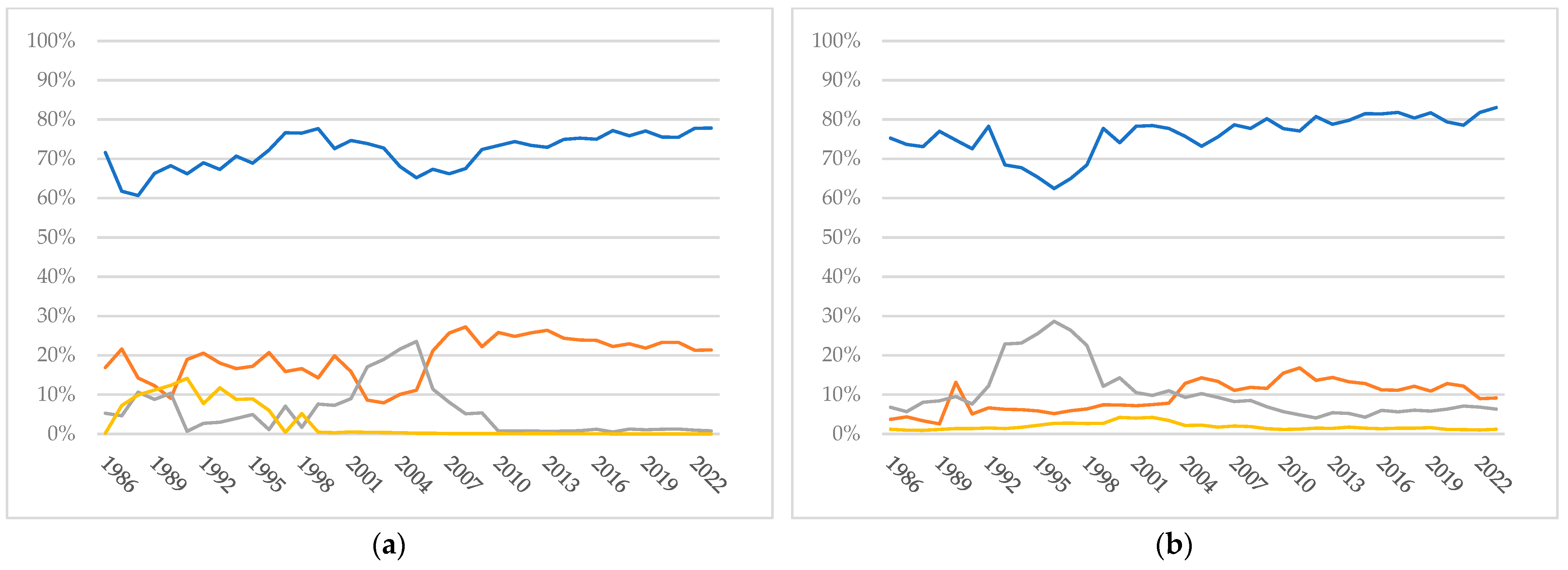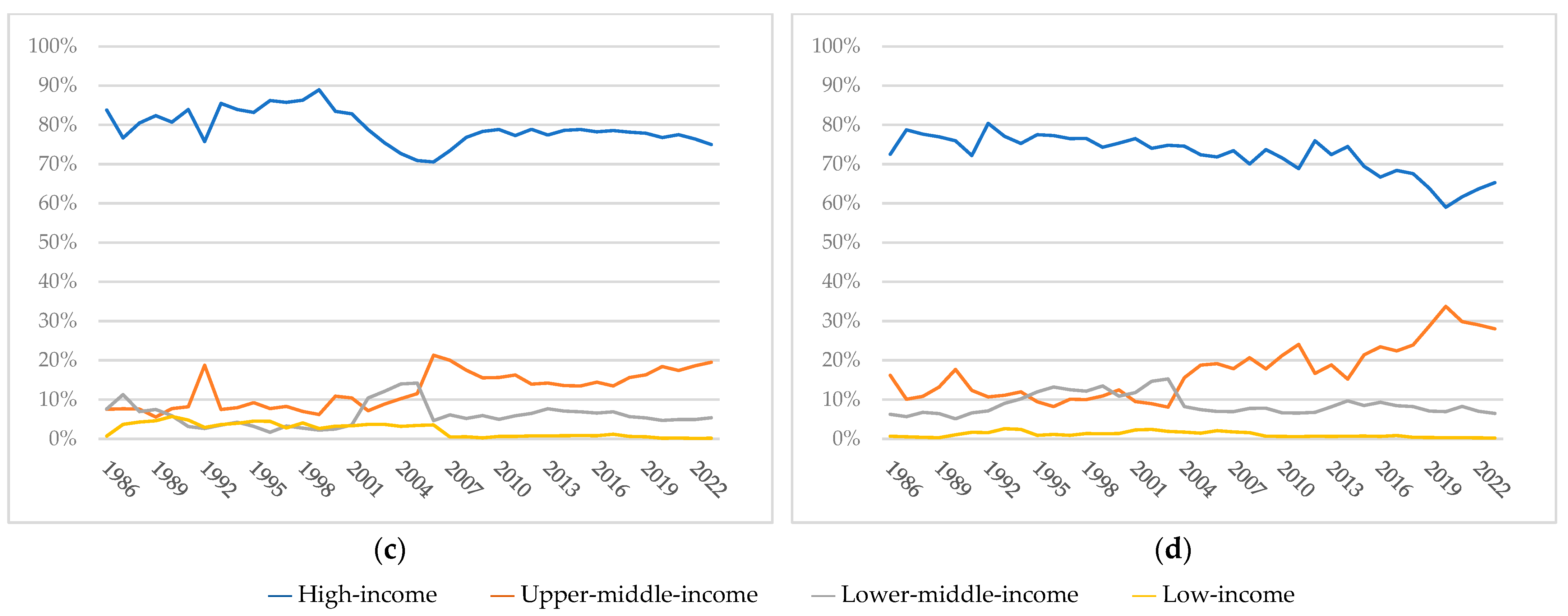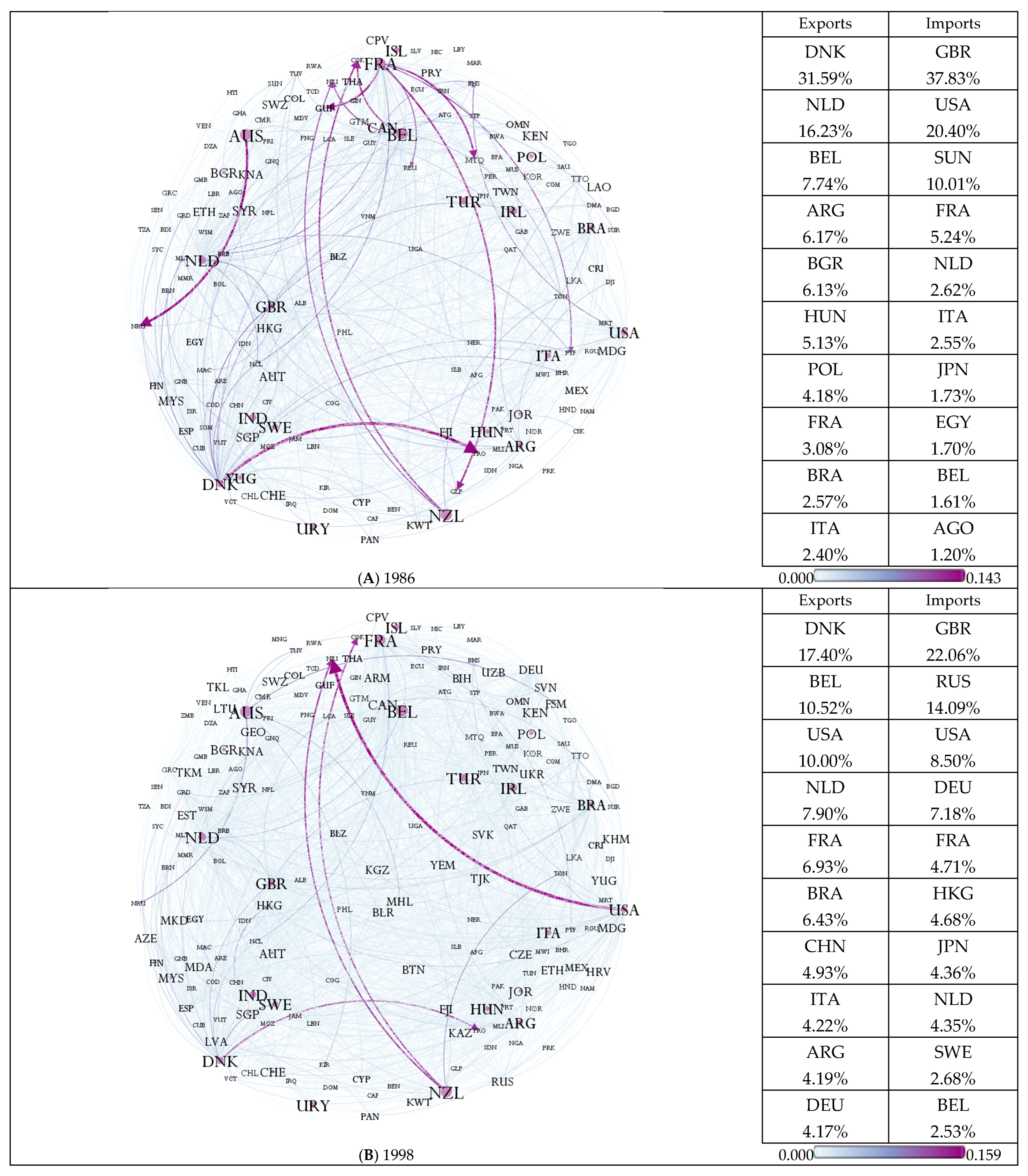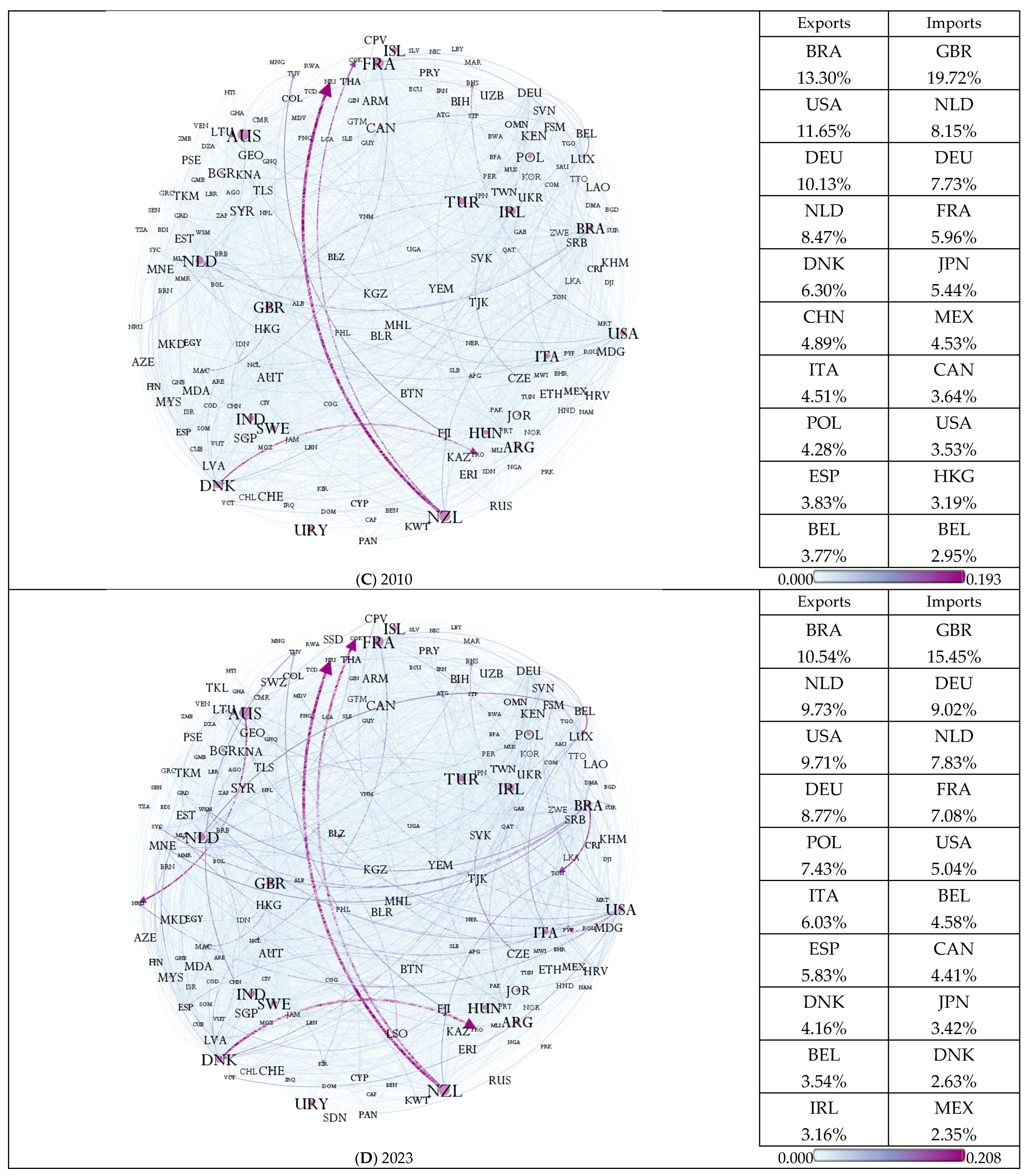Trends in Global Trade of Red Meats from 1986 to 2023: A Complex Network Analysis with Implications for Public Health
Abstract
1. Introduction
2. Materials and Methods
2.1. Data Extraction
- Processed red meats, corresponding to “frankfurters, sausages, corned beef, cured ham and luncheon meat that are made from beef, pork” according to the NCI Processed Meat Categories SAS program [48]: (a) bovine meat that is salted, dried, or smoked; sausages and similar products of such meat; offal or blood of beef and veal; beef and veal preparations; homogenized meat preparations; (b) pig meat and cuts that are salted, dried, or smoked (bacon and ham); sausages and similar products of such meat; offal or blood of pig; pig meat preparations; (c) other meat and edible meat offal, salted, in brine, dried, or smoked; (d) edible flours and meals of meat or meat offal; and (e) meat prepared n.e.c.
- Unprocessed red meats, including live animals, corresponding to “beef, veal, pork, lamb, and game meat; excludes organ meat and cured meat” [46]: (a) Cattle: meat of cattle with the bone, fresh or chilled; meat of cattle, boneless, fresh or chilled; (b) Buffalo: meat of buffalo, fresh or chilled; (c) Sheep: meat of sheep, fresh or chilled; (d) Goat: meat of goat, fresh or chilled; (e) Swine/pig: meat of pig with the bone, fresh or chilled; meat of pig, boneless, fresh or chilled; (f) Horses: horse meat, fresh or chilled; (g) Asses: meat of asses, fresh or chilled; (h) Mules and hinnies; (i) Camels: meat of camels, fresh or chilled; other camelids; and (j) Game meat, fresh, chilled, or frozen.
2.2. Network Analysis
2.3. Statistical Analysis
3. Results
4. Discussion
5. Conclusions
Supplementary Materials
Author Contributions
Funding
Institutional Review Board Statement
Informed Consent Statement
Data Availability Statement
Conflicts of Interest
References
- Miller, V.; Reedy, J.; Cudhea, F.; Zhang, J.; Shi, P.; Erndt-Marino, J.; Coates, J.; Micha, R.; Webb, P.; Mozaffarian, D.; et al. Global, regional, and national consumption of animal-source foods between 1990 and 2018: Findings from the Global Dietary Database. Lancet Planet. Health 2022, 6, e243–e256. [Google Scholar] [CrossRef]
- Williams, P. Nutritional composition of red meat. Nutr. Diet. 2007, 64, S113–S119. [Google Scholar] [CrossRef]
- Juárez, M.; Lam, S.; Bohrer, B.M.; Dugan, M.E.R.; Vahmani, P.; Aalhus, J.; Juárez, A.; López-Campos, O.; Prieto, N.; Segura, J. Enhancing the nutritional value of red meat through genetic and feeding strategies. Foods 2021, 10, 872. [Google Scholar] [CrossRef]
- Libera, J.; Iłowiecka, K.; Stasiak, D. Consumption of processed red meat and its impact on human health: A review. Int. J. Food Sci. Technol. 2021, 56, 6115–6123. [Google Scholar] [CrossRef]
- Millward, D.J.; Garnett, T. Food and the planet: Nutritional dilemmas of greenhouse gas emission reductions through reduced intakes of meat and dairy foods. Proc. Nutr. Soc. 2009, 69, 103–118. [Google Scholar] [CrossRef] [PubMed]
- Food and Agriculture Organization/World Health Organization. Sustainable Healthy Diets: Guiding Principles; FAO/WHO: Rome, Italy, 2019; Available online: https://www.who.int/publications/i/item/9789241516648 (accessed on 1 March 2025).
- Schirone, M.; Visciano, P. Trends of major foodborne outbreaks in the European Union during the years 2015-2019. Hygiene 2021, 1, 106–119. [Google Scholar] [CrossRef]
- Belk, K.E.; Woerner, D.R.; Delmore, R.J.; Tatum, J.; Yang, H.; Sofos, J. The meat industry: Do we think and behave globally or locally? Meat Sci. 2014, 98, 556–560. [Google Scholar] [CrossRef]
- Pigatto, G.; Pigatto, G.A.S. The strategy for internationalization of Brazilian meat industries and the role of the Development Bank. Inf. GEPEC 2016, 19, 126–146. [Google Scholar] [CrossRef]
- Chung, M.G.; Li, Y.; Liu, J. Global red and processed meat trade and non-communicable diseases. BMJ Glob. Health 2021, 6, e006394. [Google Scholar] [CrossRef]
- Mello, A.V.; Sarti, F.M.; Pereira, J.L.; Goldbaum, M.; Cesar, C.L.G.; Alves, M.C.G.P.; Fisberg, R.M. Determinants of inequalities in the quality of Brazilian diet: Trends in 12-year population-based study (2003–2015). Int. J. Equity Health 2018, 17, 72. [Google Scholar] [CrossRef]
- Miller, V.; Webb, P.; Micha, R.; Mozaffarian, D. Defining diet quality: A synthesis of dietary quality metrics and their validity for the double burden of malnutrition. Lancet Planet. Health 2020, 4, E352–E370. [Google Scholar] [CrossRef] [PubMed]
- Sebastian, S.A.; Padda, I.; Johal, G. Long-term impact of mediterranean diet on cardiovascular disease prevention: A systematic review and meta-analysis of randomized controlled trials. Curr. Probl. Cardiol. 2024, 49, 102509. [Google Scholar] [CrossRef]
- Sezaki, A.; Imai, T.; Miyamoto, K.; Kawase, F.; Shirai, Y.; Abe, C.; Sanada, M.; Inden, A.; Rato, T.; Sugihara, N.; et al. Association between the Mediterranean diet score and healthy life expectancy: A global comparative study. J. Nutr. Health Aging 2022, 26, 621–627. [Google Scholar] [CrossRef]
- Fekete, M.; Varga, P.; Ungvari, Z.; Fekete, J.T.; Buda, A.; Szappanos, Á.; Lehoczki, A.; Mózes, N.; Grosso, G.; Godos, J.; et al. The role of the Mediterranean diet in reducing the risk of cognitive impairement, dementia, and Alzheimer’s disease: A meta-analysis. GeroScience 2025, 47, 3111–3130. [Google Scholar] [CrossRef]
- Godos, J.; Guglielmetti, M.; Ferraris, C.; Frias-Toral, E.; Domínguez Azpíroz, I.; Lipari, V.; Di Mauro, A.; Furnari, F.; Castellano, S.; Galvano, F.; et al. Mediterranean diet and quality of life in adults: A systematic review. Nutrients 2025, 17, 577. [Google Scholar] [CrossRef]
- Popkin, B. Measuring the nutrition transition and its dynamics. Public Health Nutr. 2021, 24, 318–320. [Google Scholar] [CrossRef]
- O’Hearn, M.; Lara-Castor, L.; Cudhea, F.; Miller, V.; Reedy, J.; Shi, P.; Zhang, J.; Wong, J.B.; Economos, C.D.; Micha, R.; et al. Incident type 2 diabetes attributable to suboptimal diet in 184 countries. Nat. Med. 2023, 29, 982–995. [Google Scholar] [CrossRef] [PubMed]
- Xie, D.; You, F.; Li, C.; Zhou, D.; Yang, L.; Liu, F. Global regional, and national burden of type 2 diabetes attributable to dietary factors from 1990 to 2021. Sci. Rep. 2025, 15, 13278. [Google Scholar] [CrossRef]
- Marsh, K.; Zeuschner, C.; Saunders, A. Health implications of a vegetarian diet: A review. Am. J. Lifestyle Med. 2012, 6, 250–267. [Google Scholar] [CrossRef]
- Han, M.A.; Zeraatkar, D.; Guyatt, G.H.; Vernooij, R.W.; El Dib, R.; Zhang, Y.; Algarni, A.; Leung, G.; Storman, D.; Valli, C.; et al. Reduction of red and processed meat intake and cancer mortality and incidence. A systematic review and meta-analysis of cohort studies. Ann. Intern. Med. 2019, 171, 711–720. [Google Scholar] [CrossRef] [PubMed]
- Vernooij, R.W.M.; Zeraatkar, D.; Han, M.A.; El Dib, R.; Zworth, M.; Milio, K.; Sit, D.; Lee, Y.; Gomaa, H.; Valli, C.; et al. Patterns of red and processed meat consumption and risk for cardiometabolic and cancer outcomes. A systematic review and meta-analysis of cohort studies. Ann. Intern. Med. 2019, 171, 732–741. [Google Scholar] [CrossRef]
- Zeraatkar, D.; Johnston, B.C.; Bartoszko, J.; Cheung, K.; Bala, M.M.; Valli, C.; Rabassa, M.; Sit, D.; Milio, K.; Sadeghirad, B.; et al. Effect of lower versus higher red meat intake on cardiometabolic and cancer outcomes. A systematic review of randomized trials. Ann. Intern. Med. 2019, 171, 721–731. [Google Scholar] [CrossRef]
- Zeraatkar, D.; Han, M.A.; Guyatt, G.H.; Vernooij, R.W.; El Dib, R.; Cheung, K.; Milio, K.; Zworth, M.; Bartoszko, J.J.; Valli, C.; et al. Red and processed meat consumption and risk for all-cause mortality and cardiometabolic outcomes. A systematic review and meta-analysis of cohort studies. Ann. Intern. Med. 2019, 171, 703–710. [Google Scholar] [CrossRef]
- Sanders, L.M.; Wilcox, M.L.; Maki, K.C. Red meat consumption and risk factors for type 2 diabetes: A systematic review and meta-analysis of randomized controlled trials. Eur. J. Clin. Nutr. 2023, 77, 156–165. [Google Scholar] [CrossRef]
- Geiker, N.R.W.; Bertram, H.C.; Mejborn, H.; Dragsted, L.O.; Kristensen, L.; Carrascal, J.R.; Bügel, S.; Astrup, A. Meat and human health—Current knowledge and research gaps. Foods 2021, 10, 1556. [Google Scholar] [CrossRef]
- Johnston, B.; De Smet, S.; Leroy, F.; Mente, A.; Stanton, A. Non-communicable disease risk associated with red and processed meat consumption—Magnitude, certainty, and contextuality of risk? Anim. Front. 2023, 13, 19–27. [Google Scholar] [CrossRef]
- Wang, Y.; Pitre, T.; Wallach, J.D.; de Souza, R.J.; Jassal, T.; Bier, D.; Patel, C.J.; Zeraatkar, D. Grilling the data: Application of specification curve analysis to red meat and all-cause mortality. J. Clin. Epidemiol. 2024, 168, 111278. [Google Scholar] [CrossRef]
- Naghshi, S.; Sadeghi, O.; Willett, W.C.; Esmaillzadeh, A. Dietary intake of total, animal, and plant proteins and risk of all cause, cardiovascular, and cancer mortality: Systematic review and dose-response meta-analysis of prospective cohort studies. BMJ 2020, 370, m2412. [Google Scholar] [CrossRef] [PubMed]
- Wang, X.; Lin, X.; Ouyang, Y.Y.; Liu, J.; Zhao, G.; Pan, A.; Hu, F.B. Red and processed meat consumption and mortality: Dose-response meta-analysis of prospective cohort studies. Public Health Nutr. 2016, 19, 893. [Google Scholar] [CrossRef] [PubMed]
- Huang, J.; Liao, L.M.; Weinstein, S.J.; Sinha, R.; Graubard, B.I.; Albanes, D. Association between plant and animal protein intake and overall and cause-specific mortality. JAMA Intern. Med. 2020, 180, 1173–1184. [Google Scholar] [CrossRef] [PubMed]
- Henchion, M.; McCarthy, M.; Resconi, V.C.; Troy, D. Meat consumption: Trends and quality matters. Meat Sci. 2014, 98, 561–568. [Google Scholar] [CrossRef]
- Parlasca, M.C.; Qaim, M. Meat consumption and sustainability. Annu. Rev. Resour. Econ. 2022, 14, 17–41. [Google Scholar] [CrossRef]
- Joseph, P.; Searing, A.; Watson, C.; McKeague, J. Alternative proteins: Market research on consumer trends and emerging landscape. Meat Muscle Biol. 2020, 4, 1–11. [Google Scholar] [CrossRef]
- Samad, A.; Kim, S.-H.; Kim, C.-J.; Lee, E.-Y.; Kumari, S.; Hossain, J.; Alam, N.; Muazzam, A.; Hwang, Y.-H.; Joo, S.-T. From farms to labs: The new trend of sustainable meat alternatives. Food Sci. Anim. Resour. 2025, 45, 13–30. [Google Scholar] [CrossRef] [PubMed]
- Munialo, C.D.; Baeghbali, V.; Acharya, P. Plant-based alternatives to meat products. Foods 2025, 14, 1396. [Google Scholar] [CrossRef]
- Transparency Market Research. Meat Alternatives Market—Market Outlook Report Preview. Available online: https://www.transparencymarketresearch.com/meat-alternatives-market.html (accessed on 28 July 2025).
- Banach, J.L.; van der Berg, J.P.; Kleter, G.; van Bokhorst-van de Veen, H.; Bastiaan-Net, S.; Pouvreau, L.; van Asselt, E.D. Alternative proteins for meat and dairy replacers: Food safety and future trends. Crit. Rev. Food Sci. Nutr. 2023, 63, 11063–11080. [Google Scholar] [CrossRef]
- Gu, H.; Kong, Y.; Huang, D.; Wang, Y.; Raghavan, V.; Wang, J. Scaling cultured meat: Challenges and solutions for affordable mass production. Compr. Rev. Food Sci. Food Saf. 2025, 24, e70221. [Google Scholar] [CrossRef]
- Magalhaes, D.R.; Çakmakçı, C.; Campo, M.d.M.; Çakmakçı, Y.; Makishi, F.; Silva, V.L.d.S.; Trindade, M.A. Changes in the current patterns of beef consumption and consumer behavior trends—Cross-cultural study Brazil-Spain-Turkey. Foods 2023, 12, 475. [Google Scholar] [CrossRef]
- Qaim, M.; Barrangou, R.; Ronald, P.C. Sustainability of animal-sourced foods and plant-based alternatives. Proc. Natl. Acad. Sci. USA 2024, 121, e2400495121. [Google Scholar] [CrossRef] [PubMed]
- Food and Agriculture Organization (FAO). Transforming Food and Agriculture Through A Systems Approach; FAO: Rome, Italy, 2025. [Google Scholar] [CrossRef]
- Norde, M.M.; Porciuncula, L.; Garrido, G.; Nunes-Galbes, N.M.; Sarti, F.M.; Marchioni, D.M.L.; de Carvalho, A.M. Measuring food systems sustainability in heterogenous countries: The Brazilian multidimensional index updated version applicability. Sustain. Dev. 2023, 31, 91–107. [Google Scholar] [CrossRef]
- Darmon, N.; Drewnowski, A. Contribution of food prices and diet cost to socioeconomic disparities in diet quality and health: A systematic review and analysis. Nutr. Rev. 2015, 73, 643–660. [Google Scholar] [CrossRef] [PubMed]
- Food and Agriculture Organization (FAO). Food and Agriculture Data; FAO: Rome, Italy, 2022; Available online: https://www.fao.org/faostat/en/#home (accessed on 1 March 2025).
- O’Connor, L.E.; Herrick, K.A.; Parsons, R.; Reedy, J. Heterogeneity in meat food groups can meaningfully alter population-level intake estimates of red meat and poultry. Front. Nutr. 2021, 8, 778369. [Google Scholar] [CrossRef]
- Bowman, S.A.; Clemens, J.C.; Friday, J.E.; Moshfegh, A.J. Food Patterns Equivalents Database 2017–2018: Methodology and user Guide; Food Surveys Research Group, Beltsville Human Nutrition Research Center, Agricultural Research Service, U.S. Department of Agriculture: Beltsville, MD, USA, 2020. Available online: http://www.ars.usda.gov/nea/bhnrc/fsrg (accessed on 28 July 2025).
- O’Connor, L.E.; Wambogo, E.A.; Herrick, K.A.; Parsons, R.; Reedy, J. A standardized assessment of processed red meat and processed poultry intake in the US population aged ≥2 years using NHANES. J. Nutr. 2022, 152, 190–199. [Google Scholar] [CrossRef]
- Food and Agriculture Organization (FAO). Livestock Statistics: Concepts, Definitions and Classifications; FAO: Rome, Italy, 2011; Available online: http://www.fao.org/3/cb2461en/cb2461en.pdf (accessed on 1 March 2025).
- Silvestrini, M.M.; Smith, N.W.; Sarti, F.M. Evolution of global food trade network and its effects on population nutritional status. Curr. Res. Food Sci. 2023, 6, 100517. [Google Scholar] [CrossRef]
- Silvestrini, M.M.; Smith, N.W.; Fletcher, A.J.; McNabb, W.C.; Sarti, F.M. Complex network analysis and health implications of nutrient trade. Glob. Food Secur. 2024, 40, 100743. [Google Scholar] [CrossRef]
- Silvestrini, M.M.; Rossi, T.J.A.; Sarti, F.M. Socioeconomic and environmental dimensions of agriculture, livestock, and fisheries: A network study on carbon and water footprints in global food trade. Standards 2025, 5, 19. [Google Scholar] [CrossRef]
- World Bank. World Development Indicators; World Bank: Washington, DC, USA, 2023; Available online: https://databank.worldbank.org/source/world-development-indicators (accessed on 1 March 2025).
- World Bank. World Bank Group Country Classifications by Income Level for FY24 (1 July 2023–30 June 2024); World Bank: Washington, DC, USA, 2023; Available online: https://blogs.worldbank.org/opendata/new-world-bank-group-country-classifications-income-level-fy24 (accessed on 1 March 2025).
- Cherven, K. Mastering Gephi Network Visualization: Produce Advanced Network Graphs in Gephi and Gain Valuable Insights into Your Network Datasets; Packt Publishing Ltd.: Birmingham, UK, 2015. [Google Scholar]
- Serrano, R.; Pinilla, V. Causes of world trade growth in agricultural and food products, 1951–2000: A demand function approach. Appl. Econ. 2010, 42, 3503–3518. [Google Scholar] [CrossRef]
- World Health Organization. Infections Control Guidelines for Transmissible Spongiform Encephalopathies; WHO: Geneva, Switzerland, 2000; Available online: https://apps.who.int/iris/handle/10665/66707 (accessed on 1 March 2025).
- Sherman, D.M. The spread of pathogens through trade in small ruminants and their products. Rev. Sci. Tech. 2011, 30, 207–217. [Google Scholar] [CrossRef] [PubMed]
- Bowling, M.B.; Belk, K.E.; Nightingale, K.K.; Goodridge, L.D.; Scanga, J.A.; Sofos, J.N.; Tatum, J.D.; Smith, G.C. Central nervous system tissue in meat products: An evaluation of risk, prevention strategies, and testing procedures. Adv. Food Nutr. Res. 2007, 53, 39–64. [Google Scholar] [CrossRef]
- Rojas, H.; Romero, J.R. Where to next with animal health in Latin America? The transition from endemic to disease-free status. Rev. Sci. Tech. 2017, 36, 331–348. [Google Scholar] [CrossRef]
- United States Department of Agriculture. Agricultural Baseline Projections to 2014; USDA: Washington, DC, USA, 2014. Available online: https://www.ers.usda.gov/publications/pub-details/?pubid=37774 (accessed on 1 March 2025).
- Shang, X.; Tonsor, G.T. Sanitary and phytosanitary regulations and international red meat trade. Br. Food J. 2019, 121, 2309–2321. [Google Scholar] [CrossRef]
- Beal, T.; Massiot, E.; Arsenault, J.E.; Smith, M.R.; Hijmans, R.J. Global trends in dietary micronutrient supplies and estimated prevalence of inadequate intakes. PLoS ONE 2017, 12, e0175554. [Google Scholar] [CrossRef]
- Stuckler, D.; McKee, M.; Ebrahim, S.; Basu, S.; Nestle, M. Manufacturing epidemics: The role of global producers in increased consumption of unhealthy commodities including processed foods, alcohol, and tobacco. PLoS Med. 2012, 9, e1001235. [Google Scholar] [CrossRef]
- Friel, S.; Schram, A.; Townsend, B. The nexus between international trade, food systems, malnutrition and climate change. Nat. Food 2020, 1, 51–58. [Google Scholar] [CrossRef]
- Stanton, A.V.; Leroy, F.; Elliott, C.; Mann, N.; Wall, P.; De Smet, S. 36-fold higher estimate of deaths attributable to red meat intake in GBD 2019: Is this reliable? Lancet 2022, 399, e23–e26. [Google Scholar] [CrossRef] [PubMed]
- Wu, G.; Fanzo, J.; Miller, D.D.; Pingali, P.; Post, M.; Steiner, J.L.; Thalacker-Mercer, A.E. Production and supply of high-quality food protein for human consumption: Sustainability, challenges, and innovations. Ann. N. Y. Acad. Sci. 2014, 1321, 1–19. [Google Scholar] [CrossRef]
- Leroy, F.; Barnard, N.D. Children and adults should avoid consuming animal products to reduce risk for chronic disease: NO. Am. J. Clin. Nutr. 2020, 112, 931–936. [Google Scholar] [CrossRef]
- Barnard, N.D.; Leroy, F. Children and adults should avoid consuming animal products to reduce risk for chronic disease: YES. Am. J. Clin. Nutr. 2020, 112, 926–930. [Google Scholar] [CrossRef] [PubMed]
- Barnard, N.D.; Leroy, F. Children and adults should avoid consuming animal products to reduce risk for chronic disease: Debate consensus. Am. J. Clin. Nutr. 2020, 112, 937–940. [Google Scholar] [CrossRef]
- Hoy, M.K.; Murayi, T.; Moshfegh, A.J. Effect of animal protein intake on meeting recommendations for nutrient intake among US Adults, What We Eat in America, NHANES 2015-2018. Curr. Dev. Nutr. 2023, 7, 100027. [Google Scholar] [CrossRef] [PubMed]
- Caprara, G. The Mediterranean diet. In Nutritional Health: Nutrition and Health; Temple, N.J., Wilson, T., Jacobs, D.R., Jr., Bray, G.A., Eds.; Humana: Cham, Switzerland, 2023. [Google Scholar] [CrossRef]
- Lăcătușu, C.-M.; Grigorescu, E.-D.; Floria, M.; Onofriescu, A.; Mihai, B.-M. The Mediterranean diet: From an environment-driven food culture to an emerging medical prescription. Int. J. Environ. Res. Public Health 2019, 16, 942. [Google Scholar] [CrossRef]
- Woodside, J.; Young, I.S.; McKinley, M.C. Culturally adapting the Mediterranean diet pattern—A way of promoting more ‘sustainable’ dietary change? Br. J. Nutr. 2022, 128, 693–703. [Google Scholar] [CrossRef]
- Swinburn, B.A.; Kraak, V.I.; Allender, S.; Atkins, V.J.; Baker, P.I.; Bogard, J.R.; Brinsden, H.; Calvillo, A.; De Schutter, O.; Devarajan, R.; et al. The global syndemic of obesity, undernutrition, and climate change: The Lancet Commission report. Lancet 2019, 393, 791–846. [Google Scholar] [CrossRef]
- Gephart, J.A.; Pace, M.L. Structure and evolution of the global seafood trade network. Environ. Res. Lett. 2015, 10, 125014. [Google Scholar] [CrossRef]
- Puma, M.J.; Bose, S.; Chon, S.Y.; Cook, B.I. Assessing the evolving fragility of the global food system. Environ. Res. Lett. 2015, 10, 024007. [Google Scholar] [CrossRef]
- Suweis, S.; Carr, J.A.; Maritan, A.; Rinaldo, A.; D’Odorico, P. Resilience and reactivity of global food security. Proc. Natl. Acad. Sci. USA 2015, 112, 6902–6907. [Google Scholar] [CrossRef] [PubMed]
- Marchand, P.; Carr, J.A.; Dell’Angelo, J.; Fader, M.; A Gephart, J.; Kummu, M.; Magliocca, N.R.; Porkka, M.; Puma, M.J.; Ratajczak, Z.; et al. Reserves and trade jointly determine exposure to food supply shocks. Environ. Res. Lett. 2016, 11, 095009. [Google Scholar] [CrossRef]
- Fair, K.R.; Bauch, C.T.; Anand, M. Dynamics of the global wheat trade network and resilience to shocks. Sci. Rep. 2017, 7, 7177. [Google Scholar] [CrossRef]
- Falconí, F.; Ramos-Martin, J.; Cango, P. Caloric unequal exchange in Latin America and the Caribbean. Ecol. Econ. 2017, 134, 140–149. [Google Scholar] [CrossRef]






| Income Level | Processed Red Meat Trade | ||||
| 1986 | 1998 | 2010 | 2023 | Total | |
| Volume per capita (kg) | 0.202 | 0.298 | 0.438 | 0.453 | |
| Exports | |||||
| High-income country | 71.58% | 76.55% | 73.36% | 77.84% | 72.84% |
| Upper-middle-income country | 16.87% | 16.60% | 25.81% | 21.39% | 20.68% |
| Lower-middle-income country | 5.24% | 1.68% | 0.73% | 0.77% | 4.60% |
| Low-income country | 0.18% | 5.17% | 0.11% | 0.00% | 1.67% |
| Undefined income level | 6.13% | 0.00% | 0.00% | 0.00% | 0.21% |
| N | 65 | 82 | 112 | 113 | |
| Ranksum | 118,461.5 | 162,746.0 | 220,735.0 | 229,467.0 | |
| p | 0.9660 | ||||
| Imports | |||||
| High-income country | 75.26% | 68.41% | 77.69% | 83.05% | 77.41% |
| Upper-middle-income country | 3.70% | 6.34% | 15.45% | 9.16% | 10.57% |
| Lower-middle-income country | 6.78% | 22.54% | 5.69% | 6.32% | 9.15% |
| Low-income country | 1.20% | 2.67% | 1.16% | 1.18% | 1.75% |
| Undefined income level | 13.05% | 0.04% | 0.01% | 0.29% | 1.13% |
| N | 164 | 192 | 192 | 198 | |
| Ranksum | 424,545.5 | 612,637.5 | 76,4226.0 | 840,040.5 | |
| p | 0.0001 | ||||
| Income Level | Unprocessed Red Meat Trade | ||||
| 1986 | 1998 | 2010 | 2023 | Total | |
| Volume per capita (kg) | 1.415 | 1.951 | 2.948 | 3.315 | |
| Exports | |||||
| High-income country | 83.80% | 86.31% | 78.81% | 74.98% | 78.48% |
| Upper-middle-income country | 7.50% | 6.96% | 15.63% | 19.52% | 13.80% |
| Lower-middle-income country | 7.58% | 2.72% | 4.97% | 5.35% | 6.02% |
| Low-income country | 0.68% | 4.01% | 0.59% | 0.16% | 1.68% |
| Undefined income level | 0.44% | 0.00% | 0.00% | 0.00% | 0.02% |
| N | 73 | 98 | 111 | 114 | |
| Ranksum | 145,918.5 | 195,541.5 | 237,090.5 | 254,568.5 | |
| p | 0.7424 | ||||
| Income Level | Unprocessed Red Meat Trade | ||||
| 1986 | 1998 | 2010 | 2023 | Total | |
| Imports | |||||
| High-income country | 72.51% | 76.53% | 71.55% | 65.28% | 70.83% |
| Upper-middle-income country | 16.14% | 9.97% | 21.26% | 28.03% | 19.37% |
| Lower-middle-income country | 6.22% | 12.12% | 6.58% | 6.46% | 8.53% |
| Low-income country | 0.64% | 1.35% | 0.60% | 0.22% | 0.94% |
| Undefined income level | 4.49% | 0.03% | 0.00% | 0.01% | 0.33% |
| N | 164 | 193 | 194 | 198 | |
| Ranksum | 466,131.0 | 619,260.0 | 774,069.5 | 802,852.5 | |
| p | 0.0001 | ||||
| Processed Red Meat | ||||||
| Network Metrics | 1986 | 1998 | 2010 | 2023 | Q(37) | p |
| Average degree | 4.421 | 6.992 | 8.947 | 11.515 | 3400.000 | 0.000 |
| Average weighted degree | 0.002 | 0.003 | 0.005 | 0.006 | 2100.000 | 0.000 |
| Growth | 50% | 150% | 200% | 211.789 | 0.000 | |
| Graph density | 0.017 | 0.026 | 0.034 | 0.043 | 2100.000 | 0.000 |
| Modularity | 0.611 | 0.553 | 0.616 | 0.600 | 1700.000 | 0.000 |
| Average clustering coefficient | 0.312 | 0.368 | 0.357 | 0.398 | 153.887 | 0.000 |
| Unprocessed Red Meat | ||||||
| Network Metrics | 1986 | 1998 | 2010 | 2023 | Q(37) | p |
| Average degree | 5.643 | 8.568 | 11.162 | 13.098 | 3200.000 | 0.000 |
| Average weighted degree | 0.009 | 0.010 | 0.016 | 0.019 | 1500.000 | 0.000 |
| Growth | 11% | 78% | 111% | 255.995 | 0.000 | |
| Graph density | 0.021 | 0.032 | 0.042 | 0.049 | 1500.000 | 0.000 |
| Modularity | 0.495 | 0.557 | 0.541 | 0.546 | 1500.000 | 0.000 |
| Average clustering coefficient | 0.311 | 0.382 | 0.367 | 0.401 | 166.556 | 0.000 |
Disclaimer/Publisher’s Note: The statements, opinions and data contained in all publications are solely those of the individual author(s) and contributor(s) and not of MDPI and/or the editor(s). MDPI and/or the editor(s) disclaim responsibility for any injury to people or property resulting from any ideas, methods, instructions or products referred to in the content. |
© 2025 by the authors. Licensee MDPI, Basel, Switzerland. This article is an open access article distributed under the terms and conditions of the Creative Commons Attribution (CC BY) license (https://creativecommons.org/licenses/by/4.0/).
Share and Cite
Scartezini, A.D.A.; Sarti, F.M. Trends in Global Trade of Red Meats from 1986 to 2023: A Complex Network Analysis with Implications for Public Health. J 2025, 8, 35. https://doi.org/10.3390/j8030035
Scartezini ADA, Sarti FM. Trends in Global Trade of Red Meats from 1986 to 2023: A Complex Network Analysis with Implications for Public Health. J. 2025; 8(3):35. https://doi.org/10.3390/j8030035
Chicago/Turabian StyleScartezini, Amanda Dias Assoni, and Flavia Mori Sarti. 2025. "Trends in Global Trade of Red Meats from 1986 to 2023: A Complex Network Analysis with Implications for Public Health" J 8, no. 3: 35. https://doi.org/10.3390/j8030035
APA StyleScartezini, A. D. A., & Sarti, F. M. (2025). Trends in Global Trade of Red Meats from 1986 to 2023: A Complex Network Analysis with Implications for Public Health. J, 8(3), 35. https://doi.org/10.3390/j8030035







